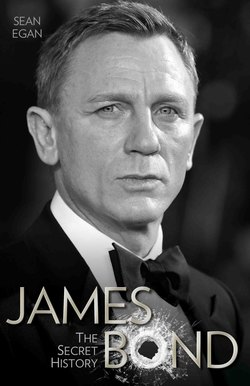Читать книгу James Bond - The Secret History - Sean Egan - Страница 6
На сайте Литреса книга снята с продажи.
ОглавлениеINTRODUCTION
James Bond first made an appearance in 1953 with the novel Casino Royale.
The writing of his creator Ian Fleming provided a new paradigm for action heroes. By blending existing thriller ingredients with his own innovations, he ramped up the power, sophistication and reach of the genre.
His protagonist stood square against Soviet evil even as it was acknowledged that his moral landscape had been complicated by the real-life treachery of the Cambridge spy ring; he was unapologetically depicted as having a full and non-marital sex life, where such behaviour was usually the preserve of villains; instead of engaging in clean, consequence-free fisticuffs, he received and dealt violence that was often untidy, grisly and a matter for regret; despite the manifold fantasy elements of his adventures, he made his way through a world recognisable as real from the brand names that Fleming took the uncommon step of sprinkling into his text. On top of all this was a newspaperman’s evocative and sophisticated writing style that left Fleming’s rough-hewn populist influences in the dust.
Despite his capturing the public imagination, the British secret-intelligence agent codenamed ‘007’ should logically long have been consigned to the dustbin of history.
In 1953, the Cold War was still raging and Britain’s Empire was sufficiently intact as to make plausible the idea that the UK could be an important player on the world espionage stage. More than half a century later, the Iron Curtain has long been torn down and Bond’s home country has been reduced to a geopolitically insignificant island. Meanwhile, sexual intercourse – casual or committed – has been turned, by the advent of reliable contraception, from a taboo into an unremarkable part of everyday life. Depictions of violence – whether celebratory or regretful – are no longer noteworthy. Even the fact that Fleming saw Bond as a ‘blunt instrument’ of state is a dated concept in a world that has long switched its affections from notions of duty to ones of personal liberty.
Yet instead of disappearing into the vault reserved for the once audacious, now merely embarrassing – see Harold Robbins – the man with a ‘Licence to Kill’ is more popular than ever. Simplify the character as they may have, the Bond films adapted from Fleming’s prose constitute the most successful franchise in cinema history. Meanwhile, the original, grittier books still hold such sway with more intellectual palates that renowned literary novelists such as Sebastian Faulks and William Boyd have been persuaded by the Fleming estate to write Bond continuation novels. Underlining Bond’s media and generation-straddling allure, N64’s GoldenEye 007 from 1997 was the most successful video game of all time. Bond film catchphrases such as ‘Bond, James Bond’ and ‘Shaken, not stirred’ have embedded themselves in society’s lexicon. Bond’s modus operandi, weaponry and jargon have become the template for all secret-agent stories. Even the glossy, gargantuan Bond-movie theme songs have created an instantly recognisable archetype.
The Bond industry has not been without hiccups. Fleming quickly began to resent writing the Bond books he tapped out at his Jamaican holiday home. He repeatedly made weary noises to his editor about his current manuscript being the last 007 novel. His shrivelling inspiration eventually led to his co-opting for a book the plot of a dormant collaborative Bond screenplay, which resulted in an unholy legal tangle and severe stress that may have hastened his own death.
The Bond films have periodically been struck by existential crises. While the public lapped up any Bond featuring the original cinema 007, the recasting process necessitated by Sean Connery’s 1967 departure raised doubts about whether the series had a future without him. His successor, George Lazenby, made only one film; Roger Moore took time to settle in and was always hated by sections of the Bond fanbase; Timothy Dalton was a Bond actor to whom the public never really took; Daniel Craig’s casting initially provoked a tsunami of contempt. The traumatic mid-seventies rupture of the production partnership of Cubby Broccoli and Harry Saltzman – who originated the series – threw a huge spanner in the works. This, though, was as nothing compared with legal battles in the 1990s that almost destroyed the franchise.
Yet Bond has ultimately proven impervious to any obstacle thrown in his path, whether it be by one of his larger-than-life adversaries such as Rosa Klebb, Oddjob or Ernst Stavro Blofeld or by the waxings and wanings of public affection and the changes in political trends. He has persevered where his real-life prototypes have passed away, and has retained a massive cultural presence where other fictional action heroes such as Sherlock Holmes, Tarzan and the Saint have been severely reduced in significance. He has also outlasted his countless imitators, from Danger Man to The Man from U.N.C.L.E. Even the mocking by the likes of Austin Powers and Johnny English of the shapes thrown by him and his antagonists could not dent Bond’s appeal. Skyfall (2012) took more money at cinemas than any of the previous twenty-two official Bond films, even allowing for inflation.
James Bond: The Secret History seeks to explain the reason for Bond’s longevity. By exploring all aspects of the billion-dollar 007 phenomenon, from books to television to radio to films to music to comics to video games to merchandise, it tries to unravel the reasons why what began in the mind of a rather melancholy newspaperman as a niche product for a select class turned into a globe-straddling icon like none before or since.
